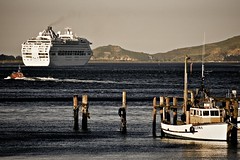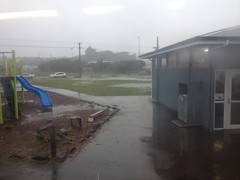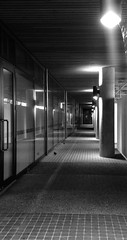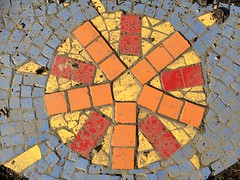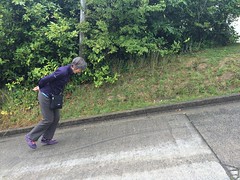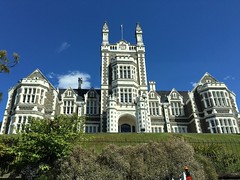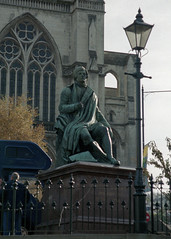Dunedin City
Dunedin (English: /dʌˈndᵻn/ ; Māori: Ōtepoti) is the second-largest city in the South Island of New Zealand (after Christchurch), and the principal city of the Otago region. Its name comes from , the Scottish Gaelic name for Edinburgh, the capital of Scotland. The city has a rich Scottish, Chinese and Māori heritage.
With an estimated population of as of , Dunedin is both New Zealand's seventh-most populous metro and urban area. For historic, cultural and geographic reasons, the city has long been considered one of New Zealand's four main centres. The urban area of Dunedin lies on the central-eastern coast of Otago, surrounding the head of Otago Harbour, and the harbour and hills around Dunedin are the remnants of an extinct volcano. The city suburbs extend out into the surrounding valleys and hills, onto the isthmus of the Otago Peninsula, and along the shores of the Otago Harbour and the Pacific Ocean.
Archaeological evidence points to lengthy occupation of the area by Māori prior to the arrival of Europeans. The province and region of Otago takes its name from the village of Otakou at the mouth of the harbour, which became a whaling station in the 1830s.
In 1848 a Scottish settlement was established by the Lay Association of the Free Church of Scotland and between 1855 and 1900 many thousands of Scots emigrated to the incorporated city. Dunedin's population and wealth boomed during the 1860s Central Otago Gold Rush, and for a brief period of time it became New Zealand's largest urban area. The city saw substantial migration from mainland China at the same time, predominately from Guangdong and Guangxi. Dunedin is home to New Zealand’s oldest Chinese community.
Today Dunedin has a diverse economy which includes manufacturing, publishing, arts, tourism and technology-based industries. The mainstay of the city's economy remains centered around tertiary education, with students from the University of Otago, New Zealand's oldest university, and the Otago Polytechnic, accounting for a large proportion of the population; 21.6 per cent of the city's population was aged between 15 and 24 at the 2006 census, compared to the New Zealand average of 14.2 per cent. Dunedin is also noted for its vibrant music scene, as the 1980s birthplace of the Dunedin sound (which heavily influenced grunge, indie and modern alternative rock). In 2014, the city was designated as a UNESCO City of Literature.
History
Māori settlements
Archaeological evidence shows the first human (Māori) occupation of New Zealand occurred between 1250 and 1300 AD, with the population concentrated along the southeast coast. A camp site at Kaikai Beach, near Long Beach to the north of the present-day city of Dunedin, has been dated from about that time. There are numerous archaic (moa-hunter) sites in what is now Dunedin, several of them large and permanently occupied, particularly in the 14th century. The population contracted but expanded again with the evolution of the Classic Māori culture which saw the building of several pā, fortified settlements, notably Pukekura at (Taiaroa Head), about 1650. There was a settlement in what is now central Dunedin (Ōtepoti), occupied as late as about 1785 but abandoned by 1826. There were also Maori settlements at Whareakeake (Murdering Beach), Pūrākaunui, Mapoutahi (Goat Island Peninsula) and Huriawa (Karitane Peninsula) to the north, and at Taieri Mouth and Otokia (Henley) to the south, all inside the present boundaries of Dunedin.
Māori tradition tells first of a people called Kahui Tipua living in the area, then Te Rapuwai, semi-legendary but considered to be historical. The next arrivals were Waitaha, followed by Kāti Māmoe late in the 16th century and then Kai Tahu (Ngāi Tahu in modern standard Māori) who arrived in the mid-17th century. European accounts have often represented these successive influxes as "invasions", but modern scholarship has cast doubt on that view. They were probably migrations – like those of the Europeans – which incidentally resulted in bloodshed.
The sealer John Boultbee recorded in the late 1820s that the 'Kaika Otargo' (settlements around and near Otago Harbour) were the oldest and largest in the south.
Early arrivals from Europe
Lieutenant James Cook stood off what is now the coast of Dunedin between 25 February 1770 and 5 March 1770, naming Cape Saunders (on the Otago Peninsula) and Saddle Hill. He reported penguins and seals in the vicinity, which led Australian, American and British sealers to visit from the beginning of the 19th century. The early years of sealing saw a feud between sealers and local Māori from 1810 to 1823, the "Sealers' War" sparked by an incident on Otago Harbour. William Tucker became the first European to settle in the area – in 1815.
Permanent European occupation dates from 1831, when the Weller brothers of New South Wales founded their whaling station at Otago (present-day Otakou) on the Otago Harbour. Epidemics severely reduced the Māori population. By the late 1830s, the Harbour had become an international whaling port. Wright & Richards started a whaling station at Karitane in 1837 and Sydney-born Johnny Jones established a farming settlement and a mission station (the South Island's first) at Waikouaiti in 1840. The settlements at Karitane and Waikouaiti have endured, making modern Dunedin one of the longest-standing European-settled territories in New Zealand.
Early in 1844, the Deborah, captained by Thomas Wing and carrying (among others) his wife Lucy and a representative of the New Zealand Company, Frederick Tuckett, sailed south from Nelson to determine the location of a planned Free Church settlement. After inspecting several areas around the eastern coast of the South Island, Tuckett selected the site which would become known as Dunedin. (Tuckett rejected the site of what would become Christchurch, as he felt the ground around the Avon river was swampy)
The Lay Association of the Free Church of Scotland, through a company called the Otago Association, founded Dunedin at the head of Otago Harbour in 1848 as the principal town
of its special settlement.
The name "Dunedin" comes from Dùn Èideann, the Scottish Gaelic name for Edinburgh, the capital of Scotland. Charles Kettle the city's surveyor, instructed to emulate the characteristics of Edinburgh, produced a striking, "Romantic" town-planning design. There resulted both grand and quirky streets, as the builders struggled and sometimes failed to construct his bold vision across the challenging landscape. Captain William Cargill (1784–1860), a veteran of the Napoleonic Wars, served as the secular leader of the new colony. The Reverend Thomas Burns (1796–1871), a nephew of the poet Robert Burns, provided spiritual guidance. By the end of the 1850s, around 12,000 Scots had emigrated to Dunedin, many from the industrial lowlands.
Gold rush era
In 1852, Dunedin became the capital of the Otago Province, the whole of New Zealand from the Waitaki south. In 1861, the discovery of gold at Gabriel's Gully, to the south-west, led to a rapid influx of people and saw Dunedin become New Zealand's first city by growth of population in 1865. The new arrivals included many Irish, but also Italians, Lebanese, French, Germans, Jews and Chinese. The Dunedin Southern Cemetery was established in 1858, the Dunedin Northern Cemetery in 1872.
The London-owned Bank of Otago opened its doors in Dunedin in 1863, opened 12 branches throughout its region, then in 1873 merged with the new National Bank of New Zealand also based in London and also operated from Dunedin but, true to its name, it rapidly expanded throughout New Zealand. Dunedin remained the principal local source of the nation's development capital until the Second World War.
Dunedin and the region industrialised and consolidated, and the Main South Line connected the city with Christchurch in 1878 and Invercargill in 1879. Otago Boys' High School was founded in 1863. The Otago Museum opened in 1868. The University of Otago, the oldest university in New Zealand, in 1869. Otago Girls' High School was established in 1871.
By 1874, Dunedin and its suburbs had become New Zealand's largest city with a population of 29,832 displacing Auckland's 27,840 residents to second place.
Between 1881 and 1957, Dunedin was home to cable trams, being both one of the first and last such systems in the world. Early in the 1880s the inauguration of the frozen meat industry, with the first shipment leaving from Port Chalmers in 1882, saw the beginning of a later great national industry.
After ten years of gold rushes the economy slowed but Julius Vogel's immigration and development scheme brought thousands more, especially to Dunedin and Otago, before recession set in again in the 1880s. In these first and second times of prosperity, many institutions and businesses were established, New Zealand's first daily newspaper, art school, medical school and public art gallery the Dunedin Public Art Gallery among them. There was also a remarkable architectural flowering producing many substantial and ornamental buildings. R. A. Lawson's First Church of Otago and Knox Church are notable examples, as are buildings by Maxwell Bury and F. W. Petre. The other visual arts also flourished under the leadership of W. M. Hodgkins. The city's landscape and burgeoning townscape were vividly portrayed by George O'Brien (1821–1888). From the mid-1890s, the economy revived. Institutions such as the Otago Settlers Museum (now renamed as Toitu Otago Settlers Museum) and the Hocken Collections—the first of their kind in New Zealand—were founded. More notable buildings such as the Railway Station and Olveston were erected. New energy in the visual arts represented by G. P. Nerli culminated in the career of Frances Hodgkins.
Early modern era
By 1900, Dunedin was no longer the country's biggest city. Influence and activity moved north to the other centres ("the drift north"), a trend which continued for much of the following centur…
Looking for places related to Dunedin City?
Those are other destinations to find places related to Dunedin City:



